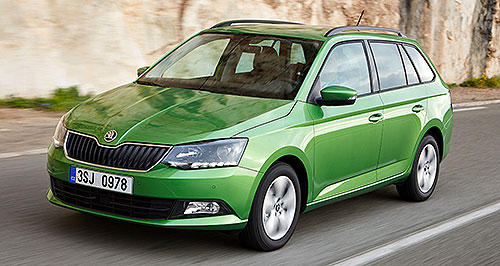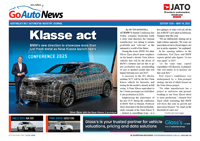Future models - Skoda - Fabia - CombiFirst drive: Skoda Fabia Combi comes of ageFabulous: Skoda's new Fabia Combi features a new design and silhouette, keeping in line with the Octavia's looks. The Skoda Fabia Combi due in July at last discovers style as Oz’s only baby wagon5 May 2015 By BYRON MATHIOUDAKIS in ITALY SKODA will launch the next-generation Fabia Combi wagon in Australia at the same time as the hatchback version in July. Adding about $1300 to the price of the NJ-series five-door – which is expected to begin from about $15,990 plus on-road costs – the Czech-built wagon will be the only vehicle offering that body style in its segment. Compared to the slow-selling Fabia wagon it replaces, the third-generation Combi is longer and wider, and sits on the same 2469mm wheelbase as its redesigned hatch sibling. Cargo space rises 25 litres to 530L over the old version with the rear seats erect, or 1395L with the split backrests folded. A wide tailgate aperture measuring in at 1028mm, combined with a low 611mm sill, make the smallest Skoda wagon easy to load. Items of up to 1.55 metres long can fit up to the back of the front seats, while a removable shelf can provide separate floor compartments. With the wheelbase length and track widths increased by 5mm and 30mm respectively, the Czech-designed Combi features a sleeker and more proportionate silhouette than before, and is in keeping with the latest Octavia’s look. The body, too, has grown by 10mm in length, is 90mm wider and 31mm lower, with the front half of the wagon identical to that of the hatch. Like all Mk3 Fabias, there is an emphasis on horizontal lines, with clean surfaces and crystalline lighting elements that are supposed to recall the Bohemian glass-making tradition. For Australia, two 1.2-litre twin-cam direct-injection four-cylinder turbo TSI petrol engines are reserved, shared with both the hatch and related Volkswagen Polo – a 66TSI (66kW of power from 4400rpm to 5400rpm and 160Nm of torque from 1400-3500rpm) mated to a five-speed manual gearbox, and an 81TSI (81kW from 4600-5600rpm and 175Nm from 1400-4000rpm) putting its outputs through a seven-speed DSG dual-clutch transmission. In European-spec guise, the 66TSI manual can average as little as 4.7 litres per 100 kilometres and 107 grams/km of carbon dioxide emissions, with the 81 TSI DSG not far behind at 4.8L/100km and 110g/km of CO2. Impressive, considering the latter is 1.8 seconds quicker to 100km/h from standstill (at 9.6s) and 15km/h faster overall (at 200km/h). Unfortunately, there are no local plans for the three-cylinder petrol or turbo-diesel units that are almost 100kg lighter. Sharing a heavily revised version of the PQ25 platform with the facelifted Polo that was released last year, all Fabias use some elements of the MQB modular transverse architecture, including advanced safety, multimedia, driveline and electrical systems. As a result, a variety of available driver-assisted safety features such as Autonomous Emergency Braking, Front Assistant (that automatically brings the car to a stop), Multi Collision Braking System (stops the car automatically after a collision to prevent further ones), front parking sensors, driver fatigue alerts, hill hold functionality, tyre pressure monitors, rain/light sensors, keyless entry/start, and a speed limiter function for the cruise control system, can now be made available. A more sophisticated and efficient climate control set-up has also been devised. An electro-mechanical rack and pinion system replaces the old electro-hydraulic unit, and is rack-mounted on the steering column for better feel and control. To cope with different weights and kinematics, the Combi’s MacPherson strut front and torsion beam rear suspension systems have been retuned. Skoda says improving ride comfort as well as improving dynamic capabilities were key priorities. Aiding the latter is the standard fitment of XDS+ electronic differential lock, maximising front-wheel traction in adverse conditions. As with the Polo, the Fabia offers VW’s Mirrorlink smartphone app tech that can display what is on your personal device’s screen, including navigation and music functionality. A special cradle in the lower console area is designed especially for phones. A large central touchscreen debuts with swipe capability. Other surprise-and-delight features include a shopping bag hooks and a 12V outlet in the cargo area, door-pocket waste bin, an oddments net on either side of the front seats and up to seven bottle holders. Plus, a panoramic glass sunroof is now on the options list. While both of the 66TSI and 81TSI sample cars on the Italian drive program included most of these items, both were manual-only, rendering the latter irrelevant for Australia. Looking just like a shrunken Octavia wagon in the flesh, the Combi is as pretty as its predecessor wasn’t, adopting the more harmonious look of the hatch we drove in Portugal last October. The cabin, too, is a lesson in elegant restraint, but is no less sophisticated for it, brandishing technology that links your compatible smartphone's screen to that of the console touchscreen unit. Unfortunately, it suffered a few gremlins, with the sat-nav app link not working properly at all. Hopefully a fix will be in place before the local launch. Traditional Skoda fans will appreciate the continuing ease of everything ahead of the driver, from the clear dials and short-reach controls, to the intuitive touchscreen interface. Vision is good, there are heaps of storage options, and lots of space to spread out – unlike in the previous model that was a tad cosy for taller folk. Only a small glovebox disappointed. Further back, the rear bench proved surprisingly resilient for the adults stuck travelling there, and of course, the cargo area is incomparable for the price and segment. Why Skoda buyers would chose the pretty hatch when the even prettier wagon offers so much space and versatility is a mystery. Similarly, despite a 24kg weight penalty, the Combi is a smooth and involving driving experience, thanks primarily to the 1.2 turbo’s strong performance across the rev range. Helped out by a sweet five-speed manual shift quality, the 66TSI feels decidedly faster than the 11.4s 0-100km/h sprint-time suggests. On the flipside, the steering lacks the pin sharpness that the design suggests, though the planted and predictable handling and roadholding properties are of the same high standard found in the Polo. Furthermore, while the ride is commendably quiet (on Tuscan roads, anyway), rougher surfaces did occasionally illicit the occasional shock, though the standard 15-inch wheel and tyre set-up would probably be better than the optional Bridgestone Turanza 215/65 R16 tyres fitted out our test car. We drove the 81TSI with the six-speed manual gearbox that we won’t be seeing in Australia in a Fabia anytime soon, and it obviously proved faster, as well as more flexible, fluid and urgent in response, though the dynamic reflexes remained about on a par. Ultimately, considering how impressive the DSG’s numbers look on paper, we’re expecting the Skoda to match the Polo version in terms of performance and driving pleasure. As it stands, the new Czech supermini offering certainly does for quality, design and showroom appeal. That the Fabia Combi is even coming to Australia is a thing to be grateful for, because it shows that at least one manufacturer recognises that not all buyers want or need heavier and more expensive compact SUVs and crossovers. If more people were open-minded and decided to take this sole light-car wagon for an extended drive, we predict that the newcomer’s sales figures would rise quickly and dramatically compared to the dumpy old version. The third-generation Fabia certainly deserves to succeed.  Read more30th of April 2015  Skoda Funstar concept ute revealedFunstar light-commercial vehicle concept created by Skoda's Academy protegesFabia pricing
Motor industry news |
Click to shareSkoda modelsResearch Skoda Fabia pricing
Motor industry news |





























Facebook Twitter Instagram